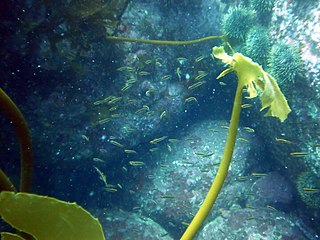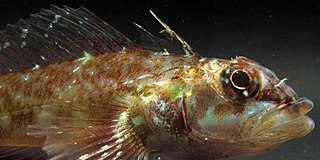
The oblique-swimming triplefin is a triplefin, found along the north east coast of the North Island of New Zealand from depths of about 5 m to 50 m. They are the only triplefins not to spend most of their time resting on the bottom, instead swimming in loose schools of up to hundreds of individuals above rocky reefs. When swimming their head is higher than the tail, giving rise to their common name.
The mottled triplefin is a triplefin of the genus Forsterygion, found around New Zealand at depths down to 30 m, in reef areas of broken rock. Its specific name honours Malcolm Francis of the Fisheries Research Centre in Wellington, New Zealand, who joined Hardy on his trips to collect specimens.

Bellapiscis lesleyae, the mottled twister, is a triplefin of the family Tripterygiidae, commonly found around the coast of New Zealand in rock pools and down to depths of about 5 m in reef areas of broken rock. Its length is up to 6 cm. The specific name of this blenny honours the New Zealand marine biologist Lesley Bolton who helped Hardy collect fishes in rockpools on the coast of New Zealand, including the type of this species.

The cryptic triplefin, Cryptichthys jojettae, is a triplefin of the family Tripterygiidae, the only member of the genus Cryptichthys, found around the coast of New Zealand. It length is up to 6 cm. The specific name honours a former staff member at the National Museum of New Zealand, Jorjette Drost, who participated in collecting specimens with Hardy.

Forsterygion is a genus of triplefins in the family Tripterygiidae native to coastal New Zealand, but also introduced to Tasmania, Australia.

Tripterygion is a genus of fish in the family Tripterygiidae, the threefin blennies, the species of which are found in the north eastern Atlantic Ocean, the Mediterranean Sea and the Black Sea.

The largemouth triplefin, Ucla xenogrammus, is a fish of the family Tripterygiidae and only member of the genus Ucla, found in the Pacific Ocean from Viet Nam, the Philippines, Palau and the Caroline Islands to Papua New Guinea, Australia, and the Solomon Islands, Fiji, Tonga, east to American Samoa and Rapa Iti, at depths of between 2 and 41 metres. Its length is up to about 47 millimetres (1.9 in). The generic name was coined by ichthyologist Richard Heinrich Rosenblatt in his unpublished dissertation of 1959 from the University of California Los Angeles and it is the initials of that institution, it was formally applied by Holleman in 1993.
Storrsia olsoni is a species of sand stargazer native to the Atlantic coast of Brazil, being endemic to Atol das Rocas and Fernando de Noronha, where it can be found in tide pools at depths of from 0 to 1 metre. It can reach a maximum length of 3 centimetres (1.2 in) SL. It is currently the only known member of its genus. The binomial name of this species honours the collector of the type, the ornithologist Storrs Olson of the National Museum of Natural History.

Enneanectes jordani, known commonly as the redbelly triplefin and the mimic triplefin, is a species of triplefin blenny from the northern Caribbean Sea and the Gulf of Mexico south as far as Venezuela. The specific name honours the American ichthyologist David Starr Jordan (1851-1931). Some authorities consider the synonym Enneanectes pectoralis to be a valid species.

The yellow triplefin ,> also known as the Abel's triplefin in South Africa, is a species of triplefin in the genus Enneapterygius. Males in this species can reach a maximum length of 2.5 centimetres. The blennies are generally bright yellow in colour, and males have black heads. They feed mostly on benthic invertebrates.
Enneapterygius cheni is a species of threefin blenny in the genus Enneapterygius. It was described by S.C. Wang, K.T. Shao, and S.C. Shen in 1996. It is a subtropical blenny found in the northwestern Pacific Ocean, and swims at depths ranging from 0–12 metres. It has been described from Taiwan and the Ryukyu Islands. Male E. cheni can reach a maximum length of 2.4 centimetres. The specific name honours the person who collected the type, Jeng-Ping Chen of the Taiwan Ocean Research Institute.
Enneapterygius clarkae, the barred triplefin, is a species of threefin blenny in the genus Enneapterygius. It was described by Wouter Holleman in 1982, and was given its species epithet in honour of American ichthyologist Eugenie Clark (1922-2015) It is a tropical blenny known from the Indian Ocean, and has been described from the Red Sea to Natal, South Africa. Male barred triplefins can reach a maximum length of 2.5 centimetres.

Enneapterygius destai is a species of triplefin blenny which is endemic to the Red Sea where it is found at depths of 2 to 20 metres in bays and lagoons which have dense populations of coral. Within these it is normally associated with corals in the genus Porites and can be found in crevices near these corals or on the vertical faces made up of them. The specific name honours the Ethiopian admiral Prince Alexander Desta (1934-1974) who was executed when the Derg took power in Ethiopia.

The black-faced blenny is a small benthic fish from the family Tripterygiidae (triplefin-blennies). It occurs at depths of 3 to 40 metres and lives on the substrate under large rocks, cliffs or other overhangs.
Enneapterygius shaoi is a species of triplefin blenny in the genus Enneapterygius. It was described by Chiang Min-Chia and Chen I-Shiung in 2008. The specific name honours the ichthyologist and marine ecologist Kwang-Tsao Shao of the Biodiversity Research Center at the Academia Sinica in Taiwan. It occurs off the eastern and southern coast of Taiwan.
Enneapterygius sheni is a species of triplefin blenny in the genus Enneapterygius. It was described by Chiang Min-Chia and Chen I-Shiung in 2008.
Enneapterygius ziegleri, known commonly as the Ziegler's triplefin, is a species of triplefin blenny in the genus Enneapterygius. It was described by Ronald Fricke in 1994. Its specific name honours Bernhard Ziegler (1929–2013), a paleontologist and Director of the State Museum of Natural History in Stuttgart, Germany. This species occurs in the Timor Sea of Indonesia and East Timor and in the Philippines.

Helcogramma steinitzi, known commonly as the red triplefin, is a species of triplefin blenny in the genus Helcogramma. It was described by Eugenie Clark in 1980. The specific name honours the marine biologist and herpetologist Heinz Steinitz (1909-1971) of the Hebrew University, Jerusalem. This species occurs in the north western Indian Ocean from the Red Sea to the Persian Gulf.
Cunningham's triplefin is a species of triplefin blenny in the genus Helcogrammoides. It was described by Frederik Adam Smitt in 1898, who named it in honour the Scottish naturalist Robert Oliver Cunningham (1841-1918), who had collected specimens of this fish from Puerto Madryn in 1868 but was unable to identify them. This species has been found in Peru, near Lima, Chile, Puerto Madryn in Argentina and the Falkland Islands.
The Leeuwin triplefin is a species of triplefin blenny in the genus Norfolkia. It was described by Ronald Fricke in 1994. This species is found in the southern part of the coast of Western Australia from the Houtmon's Abrolhos Islands to the Recherche Archipelago. It is found in rocky reefs. Its specific name references the Leeuwin Current which influences the coastal areas in which this fish occurs.












